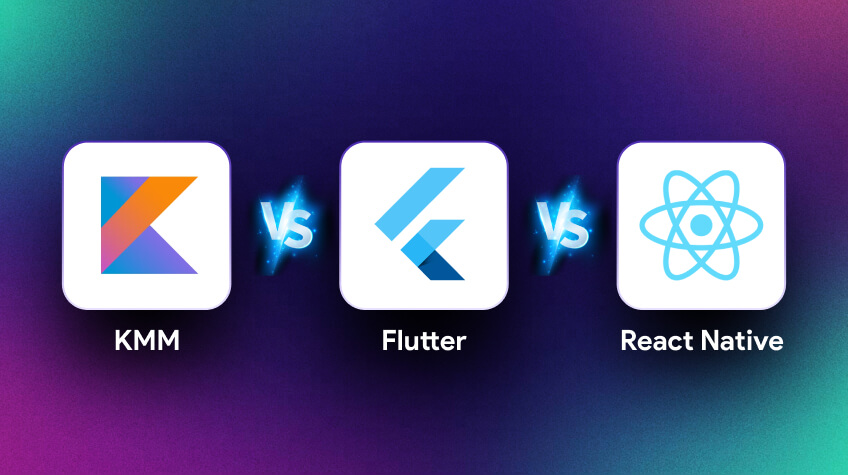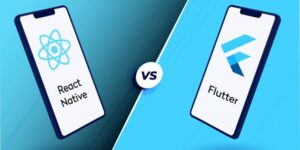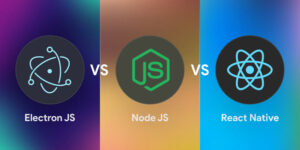
Welcome to the world of faceoff: React Native vs Flutter vs KMM! This digital world adds various advancements to people’s daily lives.
The evolution of gadgets is emerging day by day. From its humble beginnings with telephones, the world of communication has evolved into the realm of smartphones, revolutionizing the user experience. Yeah, since the launch of smartphones, they have undergone numerous advanced changes. Phone brands keep incorporating features into these modern devices, making them more advanced and innovative. In addition, there is no dearth of accessories out there. These days, when you buy a smartphone, you also get headphones and other accessories.
Additionally, numerous ongoing purchases are required to ensure a smooth experience when using your smartphones. Yes, applications! Whether it is Android or iPhone, users need an appropriate application to use their phones. But have you ever thought about how these apps are made? How do the same applications support various OS? Partnering with a Mobile app development company in Surat can help bring such applications to life across different platforms.
Do you know about it? Not yet, no worries! Programming languages, frameworks, and tools are essential for developing any application. This article gives a detailed view of frameworks and compares popular frameworks: React Native vs. Flutter vs. KMM.
Without further delay, let’s begin!
Table of Contents
Table of Contents
- Framework: An Overview
- KMM
- Flutter
- React Native
- Pros & Cons Of KMM
- Pros & Cons Of Flutter
- Pros & Cons Of React Native
- Difference Between KMM, Flutter, And React Native
- Brands Using These 3 Frameworks
- Which One Is Better?
Framework: An Overview
Before diving into the deep comparison of React Native vs Flutter vs KMM, let’s understand the basic framework. It is a structure that is the base for the application development process. What is the need for it in programming? Developers don’t need to write everything from scratch. It provides a set of tools and elements to help enhance the development process.
A framework acts like a template that can be modified to meet your project requirements. Frontend frameworks, backend frameworks, mobile application frameworks, and data science frameworks are the available types. Popular frameworks are Spring Boot, React Native, Apache Spark, PyTorch, Flutter, Django, Angular, and Koltin Multiplatform.
Among the popular frameworks, this article compares the top three: React Native vs Flutter vs KMM. Read the following line in order to gain an understanding of these three popular frameworks. Here we go…
❖ KMM
Kotlin Multiplatform (KMM) is one of the best frameworks available out there. It is a new framework for developing various applications. With this cross-platform approach, developers can create stunning applications for Android, iOS, and web. Perhaps the most notable advantage of this framework is that it allows developers to use the same code base across all three platforms. To give an idea, developers can make minor changes to the code base to use in the web, iOS, and Android apps.
Kotlin Multiplatform offers many advantages, such as better software quality, ease of learning, and support for code reusability. Various popular brands are already using KMM to build applications. Some of the popular applications built on KMM include Netflix, Careem, PlanGrid, etc. Explore further to unwrap the faceoff: Flutter vs. Kotlin Multiplatform. Here we go…
❖ Flutter
Flutter is yet another very popular and widely used framework. Many popular apps that you use on a daily basis are developed with Flutter; do you know about it? Not yet! Here it is: Google Ads, Stadia, Google Play, etc., are all developed with Flutter. It is a powerful open-source UI toolkit developed by Google. Flutter empowers developers to build high-efficiency applications for different platforms with a single codebase.
The Flutter framework can be used for both frontend and backend development. It allows developers to seamlessly create web, desktop, and cross-platform applications. For businesses looking to leverage the power of this technology, Flutter app development services provide a reliable way to build efficient and high-performing apps.It uses Dart, a reactive programming language, for a faster and easier development process. This framework offers powerful graphics and animation libraries for an easy user interface.
Let’s now learn about React Native in the upcoming section…
❖ React Native
React Native is widely used open-source framework. This open-source framework is developed by Facebook to offer exceptional performance. It gained immense popularity because of the easy learning curve and native application interface. It uses JavaScript as the programming language and supports code reusability over cross-platforms.
Features that React Native offers save a lot of time and efforts in the application development process. Utilizes the native component for ensuring seamless app functionality! Now, it’s time to know the pros and cons of the framework.
Also Read: Flutter vs React Native: Guide to Best Framework Choice
Pros & Cons Of KMM
Koltin Multiplatform offers various advantages and a few disadvantages. Explore them to identify for which project KMM is suitable.
❖ Advantages
- Easy to use and adapt
- UI is split according to every target platform
- Easily expandable, sharing code is effortless
- Scaling the existing application with KMM is possible
- Faster development and improved code quality
- Maintainable code so developers can work efficiently
❖ Disadvantages
- Still in the Alpha/Beta stage
- Comparatively small community
- Code magic and swift limitations
- Project setup is quite longer
- Tricky iOS debugging
Pros & Cons Of Flutter
Flutter lets developers build native apps for Android and iOS from a single Dart codebase. Let’s know about the benefits and drawbacks of Flutter
❖ Pros
- Offers single codebase for all platforms
- Reduced development time
- Exceptional native-like performance
- Flutter widgets support fast UI coding
- Dart programming language
- The learning curve is moderate and quite understandable
- Great documentation, learning resources, and a large community
- Robust industry adoption
- Rendering engine and hot reload feature
❖ Cons
- Dart’s low adoption
- Sometimes, the Flutter framework has problems with iOS
- Only a limited number of third-party applications
- Applications tend to be weighty ones
Pros & Cons Of React Native
React Native is an open-source framework that is free for developers and other users. Here are some of the pros and cons that you should be aware of to know whether React Native suits your project or not. Take a look…
❖ Benefits
- Accelerated development
- Fast and easy to learn
- OTA updates and supports multi-platform
- Quick iteration cycles and code reusability
- Pre-developed components
- Compatible with third-party plugins
- Cost-effective solution and simplified UI
- Enhanced stability and reliability
❖ Drawbacks
- Lack of custom modules
- A little lower performance than in native applications
- Updating issues, debugging, and troubleshooting
- Not ideal for complex interfaces
Difference Between KMM, Flutter, And React Native
Hopefully, the above section helped you understand what the three frameworks are and their pros and cons. Now, it’s time to dive right into the important section of the article, comparing these frameworks: React Native vs. Flutter vs. KMM.
❖ Key Features
Here, you get to know about the notable features of three frameworks: React Native vs. Flutter vs. Kotlin Multiplatform.
✽ KMM
- Native apps: With KMM, building 100% native applications for each platform is possible. KMM also integrates with existing code and third-party libraries. This implies that switching from Android to iOS app development is simple.
- Shared Logic: It saves developers a lot of time and effort. Shared logic let them work on both OS at the same time. For example, they can add new features and fix bugs simultaneously.
- Split UI: User interface of the app changes as per the ecosystem. UI is split for each target platform.
✽ Flutter
- Dart Programming Language: It uses Dart programming language to develop high-quality applications. Dart is quite easy to learn and use.
- Hot Reload: This feature allows you to quickly make modifications to the application without restating it. In that case, Flutter’s hot reload is unique from React Native’s.
- Expressive And Flexible UI: Flutter uses Google’s Material Design Guide to offer a flexible way to build exceptional applications.
✽ React Native
- Reusable Components: React Native Component Library is useful for reusing the elements in the application. It is the most significant feature of this framework.
- Hot Reload: One of the most highlighted features of React Native is hot reload. It is associated with Hot Module Replacement. Hot Reload offers the same group of actions and features as before.
- Extended Third-Party Support: Users can easily access the third-party applications that offer every React Native developer the freedom to avail extended resources.
Brands Using These 3 Frameworks
The theoretical explanations of KMM, React Native, and Flutter have been brought to your attention up to this point. It is going to be brought to your attention in this part. Indeed, humans make use of a variety of programmes in order to carry out a variety of jobs. However, they never give any consideration to the process of development. However, it is not necessary for most individuals to be familiar with them; however, developers should focus their attention on this aspect.
Certainly, this section is going to be the most exciting for you, as you are going to learn about the applications that were built using these three frameworks. Let’s take a look at them…
❖ KMM
KMM proves its worth on diverse platforms such as e-commerce, media streaming, healthcare solutions, and productivity apps. Some of the major platforms built on KMM include:
- Netflix
- Trello
- Cash App by Square, Inc.
- Philips
- VMware
- Memrise
- PlanGrid
- XAPO Bank
❖ Flutter
Flutter allows cross-platform development for enhanced performance and reduced development time. It is an excellent fit for payment methods, journaling appliances, smart home interconnectivity, booking apps, music platform development, games, and banking apps. Many established companies use Flutter to develop applications, such as:
- Google Ads
- Stadia
- Google Play
- eBay Motors
- BMW
- Crowdsource
- Toyota
- Etsy
- Hamilton app
❖ React Native
React Native is not new on the market. This framework is used to develop various popular applications. Yes, it includes several popular applications that you’re not aware of but use daily. Take a glance at this section to gain insight. Bloomberg
- Uber Eats
- Discord
- Skype
- Salesforce
- Walmart
- Wix
- Shopify
- Vogue
Which One Is Better?
While deciding which one of the three KMM, React Native or Flutter—is best, check the important factors. Yes, developers need to know their skill level and the type of application they want to build. Considering these two most important factors can help you pick the right one according to your project requirements.
KMM code base supports both web and mobile applications. Just with some minor changes developers can develop stunning applications for various operating systems. It is quite similar in the case of Flutter and React Native; they allow developers to write code once for mobile development.
If you’re a fresher with basic coding knowledge, then you can choose React Native. It’s the best for beginners, and the learning curve is comparatively easy. Whereas, Flutter is a great choice if the project demands a rich user interface for iOS and Android applications.
As an ending note, choosing right frameworks relies on the project demands and the knowledge of the developer. Therefore, pick one from the top three for speedy development and enhanced performance. Happy app development journey!
The Bottom Lines
So, this is all about KMM vs Flutter vs React Native. Undoubtedly, choosing the best framework may seem a little daunting at first. However, with this guide, you can easily choose the best one. There is no doubt that all three frameworks allow for the best app development. However, choosing the best among these three is crucial when it comes to developing the best application. It is important to make the appropriate decision because each of these frameworks comes with its own set of benefits and drawbacks. Keep your project’s requirements and your skills in mind while comparing React Native, Koltin, and Flutter. As a developer, you need to pick the best framework to build a user-friendly application. Happy learning! Happy coding!!
FAQs
Q1. Which one offers exceptional performance: Flutter vs. React Native vs. KMM?
All three frameworks provide great performance. However, Kotlin stands one step ahead of the other two when comparing React Native and Flutter. You can choose the one that aligns perfectly with your requirements.
Q2. What kind of apps are built with Flutter?
This open-source framework lets developers build Android, iOS, and other interactive applications that run on desktop or web pages. Its package ecosystem supports a range of hardware and services, including cameras, GPS, storage, networks, cloud storage, payments, etc.
Q3. Which framework offers enhanced UI development?
KMM, Flutter, and React Native support better UI development. But when it comes to the best UI development, React Native stands out! You are able to construct a totally native application with the help of this well-known open-source framework without compromising the user experience.






